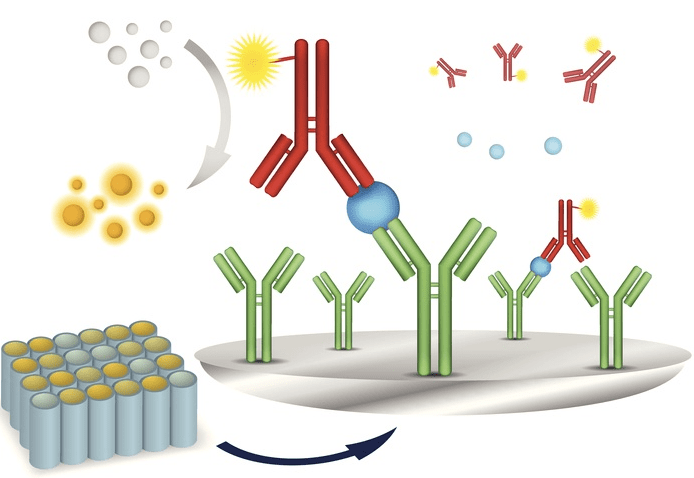Immunoassays are tests that detect the presence of a specific molecule in a sample using antibody-antigen binding reactions. Antibodies will only bind to the specific structure of a particular antigen and nothing else, making immunoassays highly specific. This makes antibodies effective reagents for detecting target molecules. As a result, immunoassays are a fundamental tool for clinical diagnostics, life science research, and industry laboratories. Different types of immunoassays can come in a range of formats, and can be used to assess varying diseases, track proteins, and detect environmental contamination.
What do Immunoassays Test For?
Immunoassays are useful when you want to detect or isolate a specific molecule within a mixture, typically a cell culture. The assay can be used to identify the presence of pathogens in a clinical sample, or it can be used to measure and quantify the amount of a target biomolecule within a complex sample. When using immunoassays to quantify an amount of target molecule, a ‘reporter’ system is needed. These reporters, also termed labels, are molecules that are chemically linked or conjugated to the antigen-antibody complex. Label-equipped immunoassays are designed to be detectable through various means, and the strength of the signal can be correlated to the amount of analyte present.
Alternatively, immunoassays can also be used to isolate and purify a specific molecule. This is performed by magnetic separation using magnetic particles, known as a magneto-actuated immunoassay. Commonly, these assays use magnetic particles that contain a core of magnetite, coated with a biologically compatible material, and chemically modified by attached antibodies. However, before designing magnetic particles for an immunoassay you must decide what type of immunoassay best fits the goals of the experiment.
What Types of Immunoassays Are There?
There are four main types of immunoassay, with sub-types of each main format. The use and types of immunoassays can be incredibly versatile, so new techniques are being developed regularly. Usually, types of immunoassays are subcategorized into those that use labels and those that do not (i.e., ‘label-free’ immunoassays). Labeled immunoassays contain an analyte which is the target antigen to be measured, an antibody, and a label that allows the molecule to be detected and quantitated.
The four most commonly used types of labeled immunoassays are:
- Enzyme Immunoassay (EIA) or Enzyme-linked immunosorbent assay (ELISA)
- Radioimmunoassay (RIA)
- Fluoroimmnoassay (FIA)
- Chemiluminescence immunoassay (CLIA)
Enzyme-linked immunosorbent assay
Enzyme immunoassays and ELISAs are simple, widely used tests that rely on highly specific antibody-antigen interactions. Enzyme immunoassays rely on the catalytic properties of enzymes within a sample to detect and quantify immunologic reactions. The umbrella of enzyme immunoassays is ever expanding and contains immunohistochemistry and immunocytochemistry, two forms of immunostaining. Enzyme immunoassays may incorporate the use of a fluorogen, and experiments can be performed in vitro or in vivo. ELISAs are a specific type of enzyme immunoassay that are used in clinical analyses. An ELISA is designed to detect and quantify soluble molecules such as antibodies, proteins, and hormones. There are four main kinds of ELISA: sandwich, competitive, direct, and indirect. These ELISAs differ in how the antibody or antigen is attached to the solid microliter plate, and how the enzymatic reaction signal is detected.
In a sandwich ELISA, for example, an antibody is immobilized on the plate. The sample containing the target antigen is added, then binds to the antibody and becomes immobilized on the plate. Next, a second, different, antibody is added, which binds to the target antigen attached to the plate, forming a ‘sandwich’ with the target antigen in the middle. The second antibody is linked to an enzyme, called a reporter enzyme, which will emit a measurable signal. To generate this signal, first any unbound antibody is washed away, and a colorimetric substrate is added. The enzyme catalyzes a reaction of the substrate, creating a color change for antibody-antigen complexes bound to the plate. The stronger the color signal, the more target antigen is present.
Other types of ELISAs also have vital applications in clinical practice, such as magneto ELISA that are a type of magnetic enzyme immunoassay. In research, these magnetic enzyme immunoassays have been used for the detection of CD4+ cells for the diagnosis of AIDS, for the detection of Plasmodium falciparum histidine-rich protein 2 (PfHRP2) a malaria parasite biomarker, and for the detection of the SARS-CoV-2 nucleocapsid protein.
Radioimmunoassay
A radioimmunoassay (RIA) uses radiolabeled antigens to measure concentrations of substances in body fluids such as blood and saliva. A radioisotope is attached to an antigen of interest and bound with its complementary antibody within a microplate. A sample that contains the target antigen is then added. The target antigen will compete with the radioactive antigen, kick it out of the binding spot on the antibody, and replace it. Next, unbound antigens are washed from the microplate, and then the radioactivity of the sample is measured. The smaller the radioactive signal, the more target antigen is present. Compared to other types of immunoassays, extra precautions are needed due to the radioactive substances involved. Regardless, RIAs are highly sensitive and specific, and are often used to detect a single hormone in a sample with many hormones present.
Fluoroimmunoassay
Fluorescent immunoassays (FIA) use a fluorescent compound as the detection reagent to detect and quantify a variety of compounds. FIAs are widely used in the in vitro diagnostics (IVD) industry and have the advantage of being fast and highly sensitive compared to other methods. In FIAs, antibodies are labeled with fluorescent dyes, traditionally being fluorescein isothiocyanate and lissamine rhodamine which emit blue-green and orange-red fluorescence, respectively, in the ultraviolet spectrum. After incubation with the antigen, the antibody-antigen complexes are isolated, and the fluorescent intensity is measured. The intensity read by this type of immunoassay is linearly correlated to the amount of antigen present.
Chemiluminescence immunoassay
Chemiluminescence immunoassays (CLIA) are a type of enzyme immunoassay. The principles of a CLIA are the same as an ELISA or fluoroimmunoassay, but the reporter is different. Luminescence is the release of light due to an electron being kicked up to a higher energy state (excitation) and emitting a photon as it relaxes down (emission). CLIA reporter systems rely on chemiluminescence, which is the emission of light based on a particular chemical reaction, i.e the formation of the antibody-antigen binding complex.
CLIA has a fast reaction time, offers a long lived emission signal, and is highly stable compared to FIA and RIA. For these reasons, CLIA is used in a range of different fields, including environmental monitoring, disease diagnosis, life sciences, and food safety. Newer techniques, such as magnetic-bead based CLIA have also widened its potential. For example, magneto-actuated chemiluminescence assays have been developed to detect the presence of Zika virus in patient samples. Compared to the other enzyme immunoassays, magnetic bead CLIAs offer higher sensitivity, increased detection rates, faster test times, low cost, and improved separation of the unbound reagents.
What Are The Advantages of Label-Free Immunoassays?
The emerging field of photonic biosensors is driving the development of a new generation of label-free assays that do not rely on central laboratory facilities. Photonics is the science of detecting and manipulating light. By using technologies developed by the electronics industry in the production of microprocessors, and adapting them to light, photonic biosensors combine photonic sensing with bio recognition technology to create label-free testing on-chip. Instead of moving electrons around on silicon chips, light is moved around on silicon chips via waveguides.
This technology has allowed the development of miniature lab-on-a-chip, label-free immunoassay (LFIA) devices. These devices are functionalized with capture antibodies and have a resonance condition towards light. This resonance wavelength shifts due to a reaction between the capture antibody and the target antigen due to a change in the change in the detected refractive index. Measuring the shift in resonance wavelength, and shift thereof, provides a readout of the binding event. Label-free assays therefore enable the detection of antigen-antibody binding without the use of an additional label, resulting in increased assay sensitivity and decreased working time.
How do I Choose an Immunoassay?
The large number of types of immunoassays can make choosing the right immunoassay for your application challenging. Here are some things to consider when making your decision:
- Decide what sensitivity you need. This is determined by the concentration of antigens you’ll be working with. A low concentration needs higher assay sensitivity to ensure detection. Also, consider your throughput requirements and cost limitations.
- Decide on the antibody-antigen pairs that you will test. Check the commercial availability, or chance of alternatively producing reagents in the laboratory.
- Decide what surface or environment you want to use. For example, you can bind antibodies or antigens to a solid plate or a magnetic bead, depending on which target needs to be observed.
Tips for a Successful Immunoassay
- Optimize blocking and washing steps. This will minimize non-specific binding, and prevent sample loss.
- Ensure your analysis method is appropriate for the type of immunoassay used. For example magnetic enzyme immunoassays require magnetic separation equipment, while CLIAs will require a luminometer and/or specialized spectrophotometer.
- Validate your immunoassay procedure. There are many published guidelines for validation of your protocol, and do not hesitate to consult the literature for techniques to ensure results are reproducible and consistent.
- Check that your sample is compatible with your immunoassay. Not all immunoassays will work for all sample types.
Find out more
Related news:





